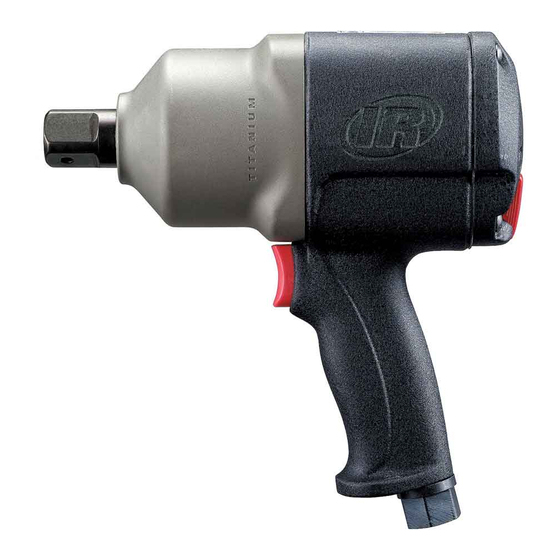
Table of Contents
Advertisement
Quick Links
Series 2925 and 2925RB Impactools are designed for use in heavy assembly work and
machinery maintenance.
Ingersoll–Rand is not responsible for customer modification of tools for applications on which
Ingersoll–Rand was not consulted.
IT IS THE RESPONSIBILITY OF THE EMPLOYER TO PLACE THE INFORMATION
IN THIS MANUAL INTO THE HANDS OF THE OPERATOR.
FAILURE TO OBSERVE THE FOLLOWING WARNINGS COULD RESULT IN INJURY.
PLACING TOOL IN SERVICE
•
Always operate, inspect and maintain this tool in
accordance with American National Standards
Institute Safety Code for Portable Air Tools
(ANSI B186.1).
•
Always operate, inspect and maintain this tool in
accordance with all regulations (local, state, federal
and country), that may apply to hand held/hand
operated pneumatic tools.
•
For safety, top performance, and maximum durability
of parts, operate this tool at 90 psig (6.2 bar/620 kPa)
maximum air pressure at the inlet with 1/2" (13 mm)
inside diameter air supply hose.
•
Always turn off the air supply and disconnect the air
supply hose before installing, removing or adjusting
any accessory on this tool, or before performing any
maintenance on this tool.
•
Do not use damaged, frayed or deteriorated air hoses
and fittings.
•
Be sure all hoses and fittings are the correct size and
are tightly secured. See Dwg. TPD905–1 for a typical
piping arrangement.
•
Always use clean, dry air at 90 psig maximum air
pressure. Dust, corrosive fumes and/or excessive
moisture can ruin the motor of an air tool.
•
Do not lubricate tools with flammable or volatile
liquids such as kerosene, diesel or jet fuel.
•
Do not remove any labels. Replace any damaged label.
USING THE TOOL
•
Always wear eye protection when operating or
performing maintenance on this tool.
The use of other than genuine Ingersoll–Rand replacement parts may result in safety hazards, decreased tool performance, and
increased maintenance, and may invalidate all warranties.
Repairs should be made only by authorized trained personnel. Consult your nearest Ingersoll–Rand Authorized Servicenter.
Refer All Communications to the Nearest
Ingersoll–Rand Office or Distributor.
Ingersoll–Rand Company 1999
Printed in U.S.A.
INSTRUCTIONS FOR
SERIES 2925 AND 2925RB
SUPER DUTY IMPACTOOLS
IMPORTANT SAFETY INFORMATION ENCLOSED.
READ THIS MANUAL BEFORE OPERATING TOOL.
03542446
•
Always wear hearing protection when operating this
tool.
•
Keep hands, loose clothing and long hair away from
rotating end of tool.
•
Note the position of the reversing lever before
operating the tool so as to be aware of the direction of
rotation when operating the throttle.
•
Anticipate and be alert for sudden changes in motion
during start up and operation of any power tool.
•
Keep body stance balanced and firm. Do not
overreach when operating this tool. High reaction
torques can occur at or below the recommended air
pressure.
•
Tool shaft may continue to rotate briefly after throttle
is released.
•
Air powered tools can vibrate in use. Vibration,
repetitive motions or uncomfortable positions may be
harmful to your hands and arms. Stop using any tool
if discomfort, tingling feeling or pain occurs. Seek
medical advice before resuming use.
•
Use accessories recommended by Ingersoll–Rand.
•
Use only impact sockets and accessories. Do not use
hand (chrome) sockets or accessories.
•
Impact wrenches are not torque wrenches.
Connections requiring specific torque must be
checked with a torque meter after fitting with an
impact wrench.
•
This tool is not designed for working in explosive
atmospheres.
•
This tool is not insulated against electric shock.
Form P7318
Edition 5
GB
September, 1999
Advertisement
Table of Contents

Summarization of Contents
Safety and Operation
Placing Tool in Service
Guidance on preparing and setting up the impact tool for use according to safety standards and optimal performance.
Using the Tool
Instructions on safe and effective operation of the impact tool, including body stance and accessory usage.
Warning Label Identification
Warning Labels
Visual identification and explanation of various safety warning labels associated with the impact tool.
Maintenance Section
Lubrication
Procedures for lubricating the impact tool's motor and impact mechanism with specified oils and greases.
Disassembly of Hammer Case and Anvil
Step-by-step guide to disassembling the hammer case and anvil assembly of the impact tool.
General Disassembly Instructions
Important general guidelines to follow before and during the disassembly of the impact tool components.
Disassembly of Quick-Change Anvil
Detailed steps for taking apart the quick-change anvil assembly of the impact tool.
Disassembly of Impact Mechanism
Procedure for disassembling the core impact mechanism, including handling of hammers and pins.
Disassembly of Reverse Valve
Instructions for removing and disassembling the reverse valve and its associated components.
Disassembly of Motor
Steps for carefully disassembling the motor, including removing the front/rear plates, rotor, and vanes.
Disassembly of Throttle Mechanism
Procedure for disassembling the throttle mechanism, including the valve seat, spring, and trigger assembly.
Assembly of Throttle Mechanism
Instructions for reassembling the throttle mechanism, including the valve seat, spring, and trigger.
Assembly of Motor
Steps for reassembling the motor, including bearings, rotor, vanes, and cylinder.
Assembly of Reverse Valve
Procedure for correctly reassembling the reverse valve, ensuring proper alignment of marks.
Assembly of Impact Mechanism
Guide to reassembling the impact mechanism, including proper placement of hammers, pins, and anvil.
Assembly of the Tool
Final steps for assembling the main tool components, including the hammer case, motor housing, and backcap.
Assembly of Square Drive Anvil
Steps for assembling the square drive anvil and spline drive anvil components to the tool.
Assembly of Quick-Change Anvil
Instructions for reassembling the quick-change anvil assembly onto the tool.
Troubleshooting Guide
A guide to identify and resolve common problems such as low power, motor failure, or lack of impact.











Need help?
Do you have a question about the 2925RB Series and is the answer not in the manual?
Questions and answers